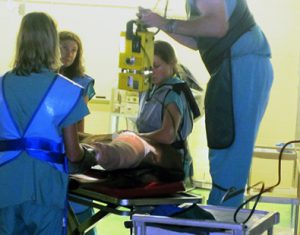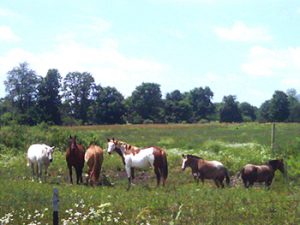Large and small animal surgeons collaborate for Lucky the mule's life-saving surgery

When Lucky was five weeks old, his owner Leon Searles came home to see the mules and mule colts all together in the pasture. “I said, ‘Oh no,’” recalls Searles. “Mule people say to keep adult mules away from colts because the mules will kill the colts.” So he rushed to rattle the grain bucket and separate the animals. Lucky followed his mom, coming around the gate fast to keep up with her.
“I saw the accident happen,” says Searles, “Lucky stopped in his tracks and his leg was just swinging.” He had fractured his tibia rushing around the fence. Searles’ local veterinarian came out to examine the colt, and the two discussed euthanasia. “That was what I initially thought we should do,” he says. However, on the advice of Searles’ daughter, they brought Lucky to MSU.
When the Searles drove up to the Veterinary Medical Center with Lucky, there were eight people outside. They put splints on the colt while he was still in the trailer, and then brought him in.
“The veterinarian at MSU said that if he were any older they’d probably have had to put him down,” explains Searles. “But since he was just five weeks old, they felt there was a chance of repairing the leg.”

Dr. John Caron, associate professor in the Department of Large Animal Clinical Sciences and a board certified surgeon specializing in orthopedic and laparoscopic surgery was in charge of the case. “The configuration of the fracture was unusually complex,” he says. “I had concerns that it might prove irreparable.”
Dr. Loïc Déjardin, associate professor of small animal orthopedic surgery, saw Caron reviewing the films of the injury and offered his help. “I said, ‘Oh that looks interesting,’” says Déjardin. “My primary interest is trauma and I love a challenge—the more complex the better— and this case definitely looked like a difficult situation.” The complexity of the fracture and the size of the colt required alternative approaches.
Déjardin recommended implants called locking plates for the procedure. He regularly uses the implants in small animals, and they were suited to this case because the mule was too small for implants made for horses.
Dejardin’s experience and knowledge was essential to the success of Lucky’s surgery. “We quite simply couldn’t have accomplished the repair without his expertise,” says Caron.
“It was a difficult procedure involving the placement of two bone plates but Lucky proved a good patient and Leon an engaged and cooperative client.” Searles watched the surgery from the viewing room and after surgery kept Lucky company in the hospital. “I only came twice a day,” he laughs.

“He’s not going to be a race mule, but he’s in great shape,” says Searles. “It was a first-class operation. And six months later Caron called to see how Lucky was doing. Human doctors don’t do that. You’ll be lucky if they stay in touch until they finish operating on you. I told him, if I need to go to the hospital with a broken leg, I want to go to the MSU clinic,” laughs Searles.
When Lucky was born, a lot of people told Searles not to name the colt Lucky. “They said bad things happen to an animal with that name. But he was one of a set of twins, and his brother didn’t make it. His brother wasn’t lucky. But Lucky survived—he was lucky,” laughs Searles. Five weeks later, he lived up to the name—surviving a fracture that could have cost him his life.
Posted: July 14, 2013
Contact: Olivia Asiala
